If there was such a thing as a time machine, it would be shaped like the lift that welcomes guests at Grand Hotel Tremezzo. They get in from the road running around Lake Como, and go up, in fact back in time, to the Belle Époque when this imposing and rich palace was built in Tremezzo, one of the Borghi più belli d'Italia. Like all the magic places of the so-called Riviera delle Azalee even in those days it was a tourist destination and a place of residence for the north European bourgeois families and the Milanese aristocracy that left Milan after the French Revolution and Napoleon’s wars. Here they built their villas, which often became literary salons: Villa Melzi, Villa Sola Cabiati, Villa Balbianello, Villa Monastero, Villa Carlotta...
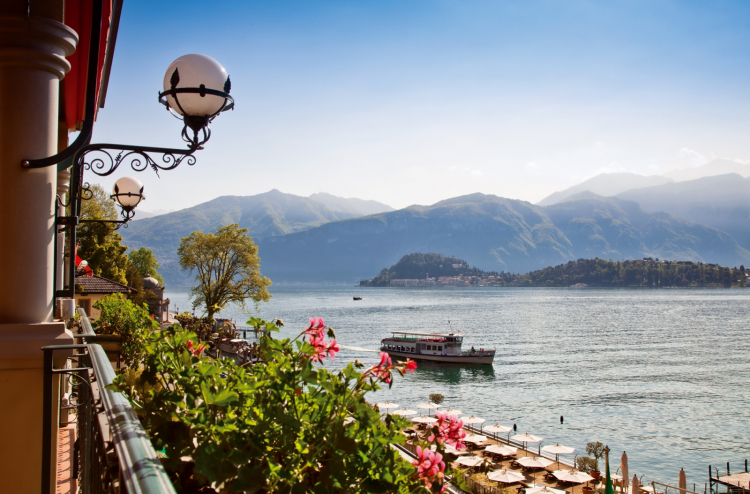
Lake Como from Grand Hotel Tremezzo
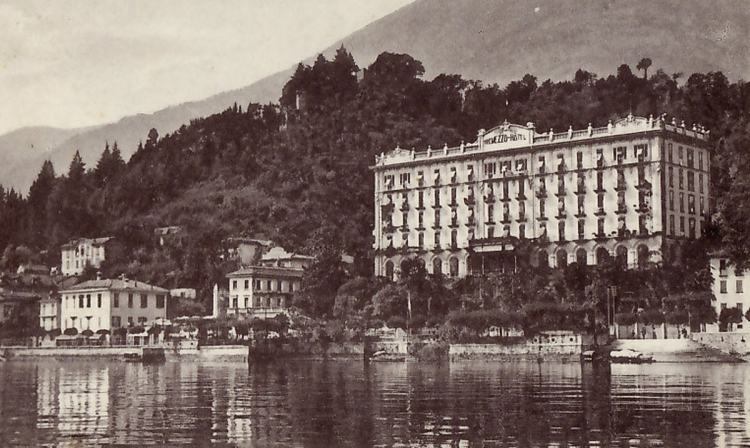
Grand Hotel Tremezzo one century ago
was a gentleman from nearby Bellagio, and he had also travelled extensively across Europe with his wife
Maria Orsolini. Their
Grand Hotel Tremezzo opened on the 10th July 1910. Its five stars never stopped shining and passed through different eras and ownerships preserving their luxury. First owned by the
Gandolas, then the
Sampietros, now the
De Santis family thanks to young
Valentina: «I was born by Lake Como and I learnt to understand it, to love it, to be surprised by its marvels ever since I was I child. I remember when my father and my granddad
Bat took me on a boat to Balbianello for a picnic on the banks of the lake, with silver cutlery and a white linen tablecloth...».
These are fragments from the past, which you can fully experience again at
Grand Hotel Tremezzo, thanks to its beautiful building. And in general thanks to the fact it welcomes guests with the infinite attention, finesse, kindness, hospitality and charm that already made the stay unforgettable, one century ago.
I’m writing this so as to give the right acknowledgement – even from myself – to one of the greatest places of Italian hospitality, which stands out thanks to its capacity to preserve the
allure of the past, and bring it to our days. However, to tell the truth, while admiring the retro charm I was afraid the latter would also be applied in the kitchen.
Beauty is timeless,
Taste, on the other hand, changes. So my approach to
La Terrazza, the most famous restaurant inside the
Grand Hotel, was sceptical. Both because the restaurant is the expression of this hotel (what if this approach respectful of the past translated into an antique, outdated cuisine?), and because here you can taste a menu entirely signed by
Gualtiero Marchesi. It draws from recipes from the Maestro, and as of July, when the menu at
Il Marchesino in Milan is expected to change, it will be the only place in the world to do so. The tasting was dutiful and obsequious, also as a tribute to
Gualtiero; instead, I was afraid of the judgment I was to give. That is to say afraid that the dishes might not honour his memory; or, even worse, that they showed that time has gone by.
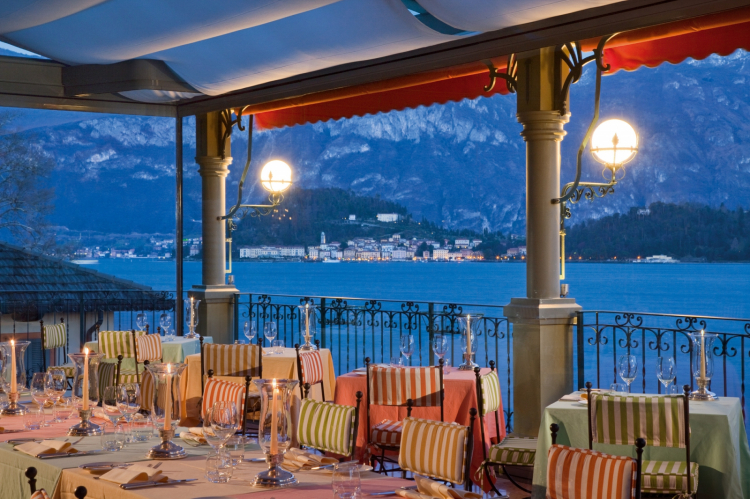
Restaurant La Terrazza. We had a great dinner, though we didn’t like everything: for instance, the tables were too small, the bread should be changed
Gladly, this was not the case. Dining at
La Terrazza means diving into a different dimension, accepting you must come to terms with a cuisine that has nothing to do with avant-garde, and is untouched (or almost untouched) by contemporaneity – didn’t
Marchesi himself say he was distant from today’s trends? Still, in this space-time short circuit, our dinner was lovely, very fun, enjoyable, excellent. Unique. An experience worth trying.
This was surely thanks to Marchesi’s genius. Even today, his dishes can stimulate the palate with elegance. They’re hardly ancient, because they have (they already did at the time) many features that today’s gourmets like: freshness, respect for products, neatness, complexity, elegance, seasonality, aesthetics, lightness.
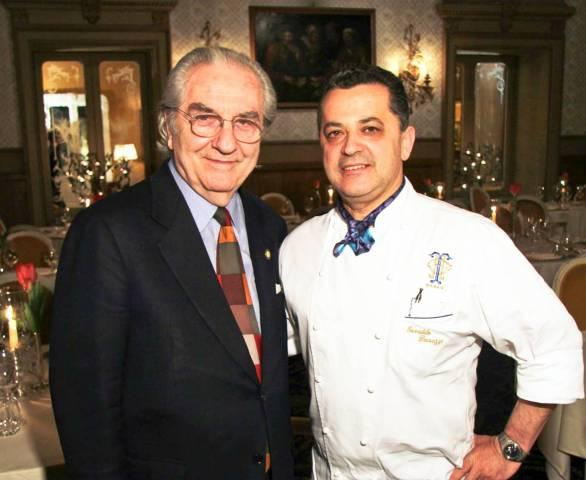
Gualtiero Marchesi and Osvaldo Presazzi
The merit also goes to the serious professionals who take on the task of continuing to evoke such heritage. These are
extra-ordinary people, who like the entire hotel seem specifically designed, part of an incredible script, halfway between
Poirot and the
Grand Budapest Hotel. Take
Osvaldo Presazzi: born in 1962, in Caspoggio in Val Chiavenna, he has been in Tremezzo for almost 30 years, after livening up the kitchens of historic, mythical five star hotels:
Ritz and
Crillon in Paris,
Carlton and
Martinez in Cannes...
«I’m here since 1989. In 2011, when I was already 49 I would have never expected to work with the Maestro, then our owners asked Marchesi as consultant, and they signed a contract that allowed us, since then, to serve the menu he created. He was then at Albereta, «can we send our chef there, so he can learn your cuisine?», we asked. He said: "But first I want to meet you in Tremezzo". He came once, and then returned again and again», he was happy because he knew the area. In fact, he had had friends nearby, in Lenno, the Salice family, the same of legendary Eliseo Salice, head chef at Villa D'Este in Cernobbio in the Thirties. The Maestro writes in Marchesi si nasce, questa è la mia storia: "At Mercato [his parents’ restaurant] I had the chance to meet talented chefs such as Remo and Giovanni Salice, respectively pastry chef and chef, the sons of the famous Eliseo". [They tell us that the heirs of that family of great chefs still work in Lenno, at an inn called Grifo, offering the typical laghèe cuisine prepared by Antonio and Tiziana Bianchi, grandchildren of Antonio Bianchi and Maria Salice).
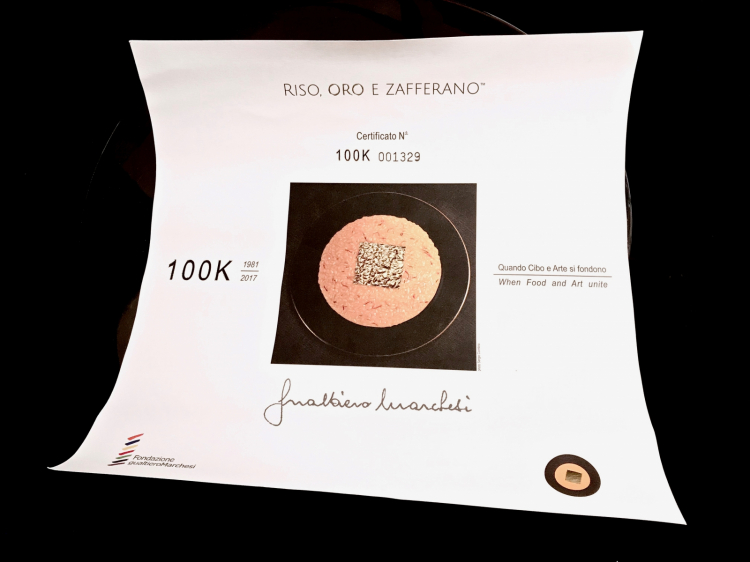
All those who eat the famous Rice, gold and saffron receive this parchment that certifies the tasting, "100.000 riso, oro e zafferano dal 1981 al 2017", and refers to a request made by Marchesi himself, who was curious to know, last year, how many of these dishes had been served till then. After some rough calculations, after discussing this with the suppliers of the gold leaves, they reached a total sum of around 100,000 dishes. Since then, each serving is numbered. Ours was number 1,329
continues his story: «When I first met
Gualtiero, my legs were shaking. He was already 81 and he calmed me. "Don’t worry,
Osvaldo. I’m here to learn too. There’s no end to what you can learn...”». Indeed even
Presazzi, who was an accomplished chef already, learnt a lot: «What? I’ll sum it up in three words, that are in fact the essence of Marchesi’s style:
freshness, naturalness, pureness. I’m honoured to present the ideas of the Maestro to our guests».
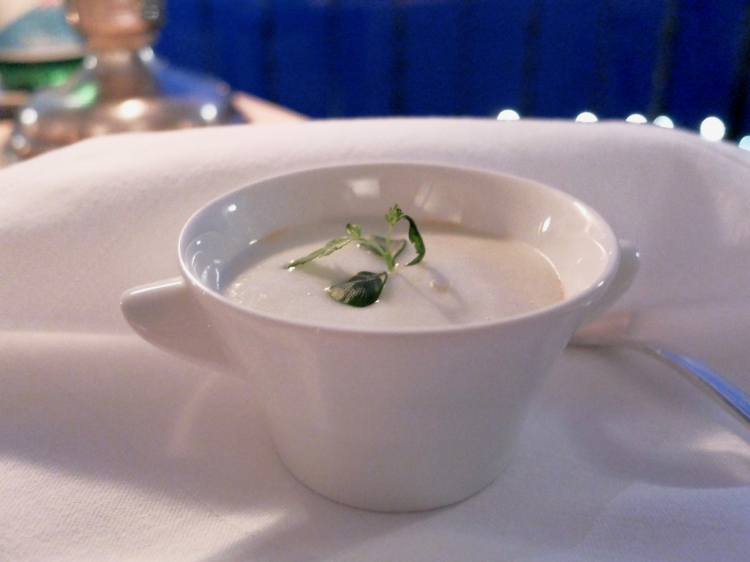
Appetizer: Mousse of potatoes with lobster. Tanio Liotta took the photos of the dishes

Scallops, Riesling and pink pepper
They make a
Gualtiero Marchesi menu that is obviously admirable given the original structure, but also thanks to its execution, its perfect cooking procedures, raw materials and technique, truly celebrating a past and present greatness. It includes:
Scallops, Riesling and pink pepper, elegant and delicious with the acid counterpoint given by the wine and butter sauce;
Rice, gold and saffron, the icon of the first Italian fine dining;
Wild sea bass filet wrapped in salt, hay, camomile and stewed artichoke, the most modern dish, with the delicate vegetal caressing the fish, reaching absolute harmony;
Veal fillet à la Rossini according to Gualtiero Marchesi, which is in fact a rather old, superfluous recipe, with the meat surrounded by foie gras, black truffle, a thick fond of Porto; and finally
Millefoglie of ovis mollis, mascarpone cream and fruits of the forest.
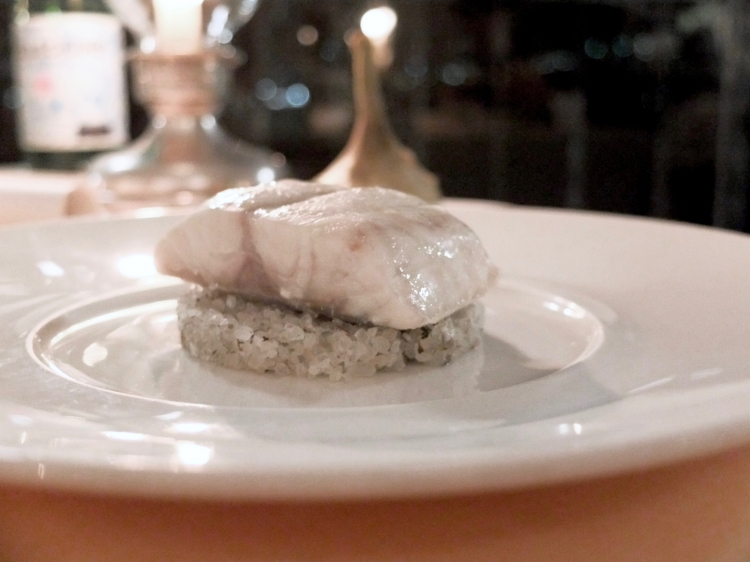
Wild sea bass filet wrapped in salt, hay, camomile and stewed artichoke. Served on a base of salt
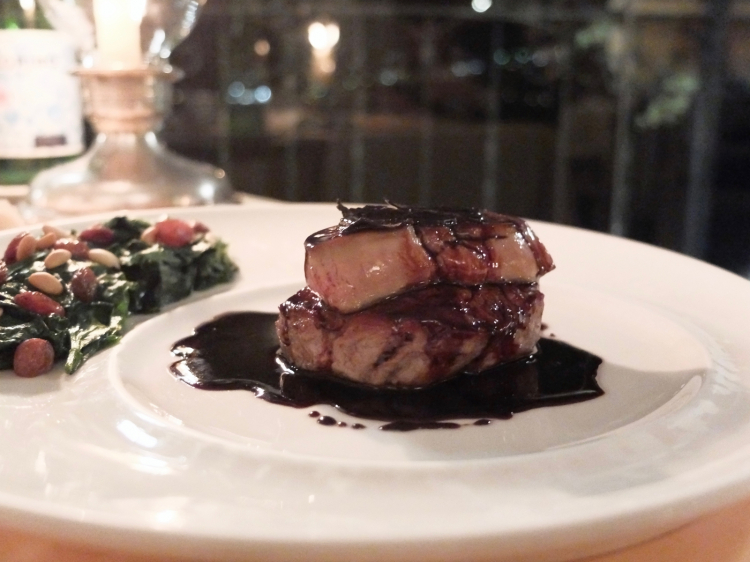
Veal fillet à la Rossini according to Gualtiero Marchesi
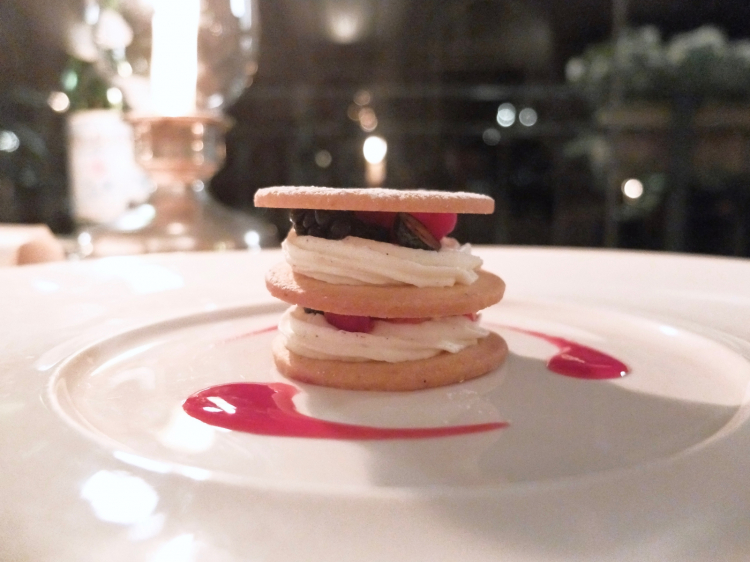
Millefoglie of ovis mollis, mascarpone cream and fruits of the forest
At
La Terrazza this tasting menu by
Marchesi stands out (dishes change based on the season, but they’re always chosen among the Maestro’s classics); his recipes can also be found in the other restaurant areas of the
Grand Hotel (at the
T Bar, for instance, we enjoyed an extraordinary
Tuna goulash, seven perfectly seared cubes of tuna, with crispy shallot, reduced wine and sprouts. Very good); plus at
La Terrazza the à la carte menu offers other classics of
hôtellerie fine dining, with equally successful results.

Excellent and fresh, at T Bar, the Raw sea bass with cucumber broth, cumin, green and red apple, Maldon salt. For the broth, they ferment the cucumber for 15 days in water, rice vinegar, ginger, chilli pepper, salt and sugar
At this point, it’s time to introduce another character in this story:
Francesco Licciardo, restaurant manager, from Mugnano, near Naples, a brand new acquisition at the
Grand Hotel. When we ask him to add a dish to Marchesi’s tasting menu, and ask him that this dish be one of the two "alla lampada" [flambé], that is to say
Veal kidney and Calvados (the other is
King prawns with Cognac), he beams: «I’m glad. In fact I was hoping you would ask me to. For me it’s a joy each time. A new declaration of love for my beautiful profession». After the ancient and spectacular table ritual, the pleasure for the eyes translates into a rich enjoyment for the palate. In a way, it’s
démodé eating (and who knows when it will be trendy again...), but at least once in a while it’s unforgettable.
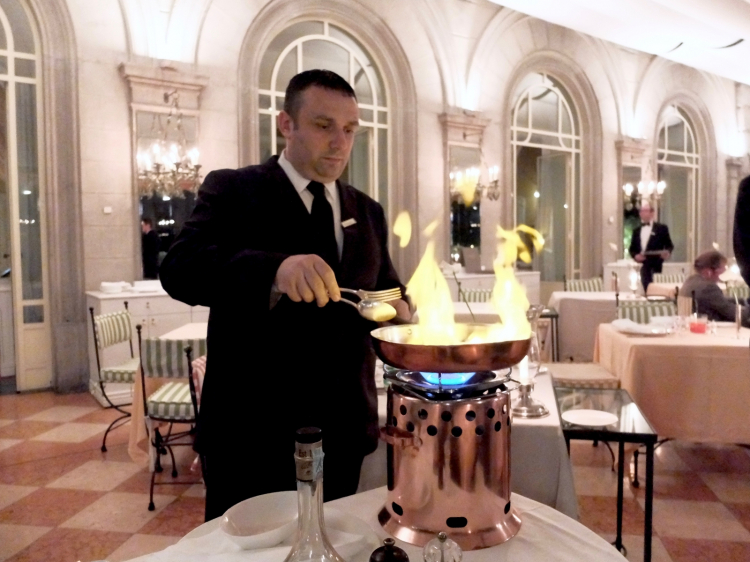
Francesco Licciardo prepares Kidneys with Calvados
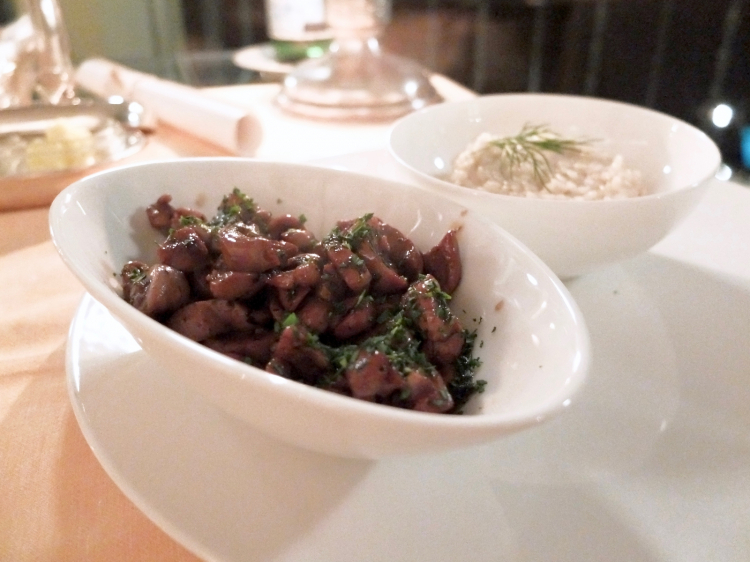
Veal kidneys with Calvados
We ask
Presazzi if he applies changes to the Maestro’s recipes, if he personalises them or makes them current. He shies away: «No, everything follows
Marchesi’s indications» even though something emerges in between the lines. The cooking times are slightly shorter, because
Gualtiero himself hated this Italian keenness on
overcooking, but today our fine dining has perfectly embraced this battle, so much so it requires even shorter cooking.
Presazzi is
tranchant: «Every recipe must be cooked to the point». Full stop.
Plus there’s another means through which the chef thinks he can reproduce the greatness of Marchesi: «I met a great pupil of his a while ago, Tiziano Rossetti [teacher at Alma, now working at L'Angolo Divino in Urbino]. After Gualtiero died, the owners asked me how I could best preserve his heritage. I said I would be very happy to do so, only with the help of Tiziano. So last February we studied a series of recipes together in pure Marchesi-style, capable of recreating the typical harmony of flavours». This resulted in dishes such as Forest egg on fondue of leek, truffle and casera, Risotto with caprino cheese, candied citron and chives, Lamb leg with caramelised onions... You can taste them at Grand Hotel Tremezzo of course.
Translated into English by Slawka G. Scarso